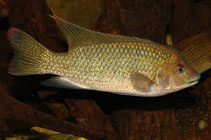| Family: |
Cichlidae (Cichlids), subfamily: Pseudocrenilabrinae |
| Max. size: |
25 cm TL (male/unsexed) |
| Environment: |
benthopelagic; freshwater; brackish, |
| Distribution: |
Africa: Guinea Bissau (Corubal River) to Liberia (Lofa River)(Ref. 52307, 53405). |
| Diagnosis: |
Dorsal spines (total): 13-16; Dorsal soft rays (total): 12-14; Anal spines: 3-3; Anal soft rays: 8-10. Diagnosis: lower pharyngeal bone about as long as broad, and with anterior lamella shorter than toothed area; median pharyngeal teeth not broadened; dorsal fin with 13-16 spines and 12-14 soft rays; soft dorsal and upper tip of caudal bordered with orange-red; "tilapia" spot clearly marked even in adults; dorsal and caudal fins not or feebly blotched (Ref. 53405).
Description: deep-bodied; mouth small; caudal fin slightly rounded (Ref. 52307). Outer jaw teeth bicuspid and non-spatulate, inner jaw teeth tricuspid, posterior pharyngeal teeth tricuspid with the lower cusp rather small; micro-gillrakers present; scales cycloid; pectoral region covered with very small scales (Ref. 53405).
Coloration: in life: adults: ground colour greyish to silvery, more whitish on belly and rather dark grey on back, occiput and snout; sides with 5-6 faint cross bars and horizontal band; lower part of cheeks and subopercle bright orange-red, and traces of this colouration on opercle and breast; first 1/4 of spinous part of dorsal fin uniformly grey, posterior part with 2-3 rows of light oblique bars between spines; soft part of dorsal fin with irregular light spots; well visible "tilapian" spot; distal margin of dorsal fin black on spinous part, orange-red on soft part; anal fin dark grey, with distal margin lighter and some light spots posteriorly; pelvic fins with black anterior margin: caudal fin with orange-red upper angle and light spots forming a network on proximal part and transverse series on distal part (Ref. 53405). Dorsal, caudal and anal fins often with red margin, sometimes their bases also appear reddish (Ref. 52307). Juveniles: less colourful than adults; anterior part of spinous dorsal fin and distal areas of soft dorsal and caudal fins darker, with much more black between branched rays (Ref. 53405). |
| Biology: |
Seems to prefer brackish regions and coastal lagoons; probably has a high tolerance for elevated salinity levels; herbivorous; pair-bonding, open substrate spawner, with both parents guarding the brood (Ref. 52307). |
| IUCN Red List Status: |
Least Concern (LC); Date assessed: 23 November 2019 Ref. (130435)
|
| Threat to humans: |
harmless |
| Country info: |
|
Source and more info: www.fishbase.org. For personal, classroom, and other internal use only. Not for publication.

